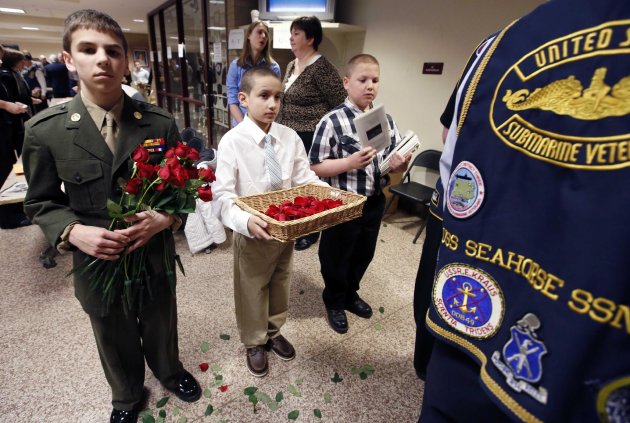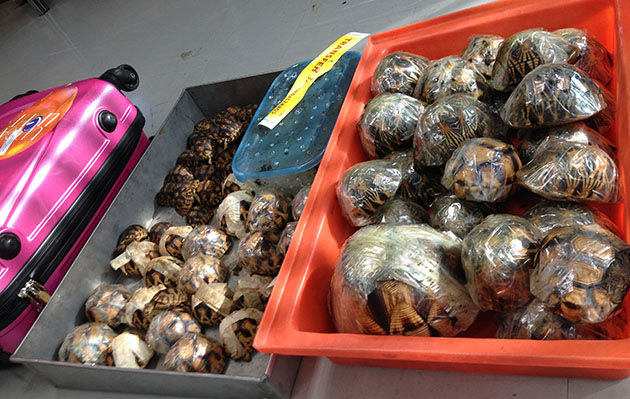Utah cabin burglar ends long run in wilderness
Troy James Knapp was dodging authorities, again.
The fugitive with a fondness for whiskey and a dislike of living near people had been wanted for a string of break-ins for years at cabins in Utah's mountains. With each near miss, each wanted poster and each threatening note left behind for law enforcement, the legend of him only grew.Knapp survived by holing up inside the cabins, sleeping in the owners' beds, eating their food and listening to their AM radio for updates on the manhunt. And then, authorities say, he would take off, stealing items such as guns and high-end camping equipment and vanishing into the woods where he lived off dandelions and wild game.
Over Easter weekend, authorities were on his trail, again.
By Tuesday, his life on the lam came to an end, done in by an educated guess by searchers who had grown to know his tendencies, the tracks he left with his snowshoes and the sounds of him chopping wood outside a cabin near a mountain reservoir.
A team of 14 officers approached him on snowshoes — the only way to quietly sneak up on him — and called in reinforcements to help corner the bearded and camouflage-clad fugitive, a trim 45-year-old standing 5-foot-8.
Now in police custody, Knapp is
telling authorities how he managed to evade them for so long across a
mountainous region stretching for 180 miles. "He really has a
fascinating story to tell, and right now he's willing to tell it," Sanpete County Sheriff Brian Nielson said.
Knapp, born in Saginaw, Mich., got into trouble with the law early.
As a teenager, he was convicted of breaking and entering, passing bad
checks and unlawful flight from authorities, according to court records.
His most serious offense, an arrest for felony assault in Michigan, was
reduced in 1994 to a charge of malicious destruction of property after
he agreed to plead guilty.
"He says, 'I don't hate people. I just don't like living with them,'" Sevier County Sheriff Nathan Sheriff Curtis said.
With no known occupation, Knapp drifted across the country and ended
up in prison in California for burglary. He fell off the radar in 2004
when he "went on the run" while on parole, said Bobby Haase, a spokesman
for the California Department of Corrections and Rehabilitation.By 2007, Utah authorities began investigating a string of cabin burglaries they believed were tied to one person. It wasn't until early 2012 that they identified Knapp as the suspect from cabin surveillance photos and fingerprints lifted from one cabin. In one photo, he was wearing camouflage, a rifle was slung over his shoulder and he had purple-colored aluminum snowshoes on his feet. Knapp appears to have aged considerably from a 2001 California mug shot.
Tracy Glover, chief deputy sheriff in Kane County, said it was fairly easy to identify Knapp's cabin habits. Knapp would drink any coffee and alcohol he could find, authorities say. Unlike typical burglars, he never took large or expensive appliances such as TVs or stereos. He took only what he could carry, mostly camping gear and weapons he stashed in abundance in the woods. He returned to burglarize cabins more than once, even swapping one stolen rifle for another, officials said.
A few years ago, investigators found an abandoned camp they linked to Knapp. It had a doomsday supply of dehydrated foods, radios, batteries, high-end camping gear, 19 guns and a copy of Jon Krakauer's "Into the Wild," a book about a young man who died after wandering into the Alaskan wilderness to live alone off the land.
It was in Kane County, near Zion National Park, where authorities lifted Knapp's fingerprints from items in a cabin. The prints matched sets in criminal databases, giving law enforcement confidence that he was their guy.
Knapp is believed to have left that area in early 2012. He started to make his way north from Kane into Sevier, Sanpete and Emery counties, where he was occasionally spotted by hunters. Knapp has told detectives he was feeling stressed trying to hide from hunters last fall, said Brian Nielson, the sheriff in Sanpete County.
Court records from multiple Utah counties indicate Knapp regularly spent several days in snowbound cabins, exhausting the food and firewood before moving on. Authorities say the signature clue of his presence was an empty bottle of whiskey. In summer, he retreated to makeshift camps deep in the backcountry.
He sometimes tidied up a cabin, but other times left it a mess or riddled with bullets, authorities say. He was known to deface religious icons. He scrawled notes for cabin owners, alternatively thanking them or demanding they "get off my mountain." He also warned sheriffs he was "gonna put you in the ground!"
Even authorities have found something to admire in Knapp's knack for survival and evasion. He stepped on saplings to avoid leaving discernible boot tracks and changed stolen footwear often to confuse searchers. He walked alongside trails instead of on them and kept mostly to backcountry.
He used some of those tactics in his final flight, which started more than a dozen miles away from his capture site. At Joe's Valley in the Manti-LaSal National Forest, deputies found boot prints around two burglarized cabins. The tracks led in no apparent direction, Emery County sheriff's Cpt. Jeff Thomas said.
Deputies copied his silent mode of travel on snowshoes over three days and nights as they tried to track Knapp across rugged terrain, first losing his size-10 shoe prints, then regaining his tracks on snowshoe as he ventured higher on the 10,000-foot Wasatch Plateau.
"They stayed quiet and built no fires — and they were very cold," Thomas said.
To get this far, deputies had to think like Knapp. He moved often and swiftly across the backcountry, covering 20 miles in a day "and that was nothing for him," Curtis said.
They had to imagine where Knapp might have taken off. They guessed it was a collection of cabins a dozen miles away at a high-altitude reservoir. They believe Knapp had visited there before. Along the way, they picked up his snowshoe tracks.
With 13 cabins at the reservoir, "we didn't know exactly where he was," U.S. Forest Service officer Scott Watson said. "We couldn't just go knocking on doors."
By 10 a.m. Tuesday, 40 officers took positions around the 9,000-foot reservoir. Knapp fired off a handful of shots at a helicopter that flushed him out of a cabin. He tried to escape into the woods, but ran into three armed officers. He laid down his rifle and surrendered.
The last three nights Knapp spent as a fugitive were in a framed log cabin with a commanding view of forest roads leading to Ferron Reservoir. Owner Eugene Bartholomew said "it was kind of messed up" and "stunk like crazy." It wasn't his only discovery. On television news, Bartholomew took his first look at Knapp.
"That son-of-a-bitch has got my coat on," he said.







 Louisville
guard Kevin Ware was up and walking on crutches Monday morning,
and coach Rick Pitino said his player's spirits have been boosted
by the outpouring of support from friends and fans.
Louisville
guard Kevin Ware was up and walking on crutches Monday morning,
and coach Rick Pitino said his player's spirits have been boosted
by the outpouring of support from friends and fans. 

